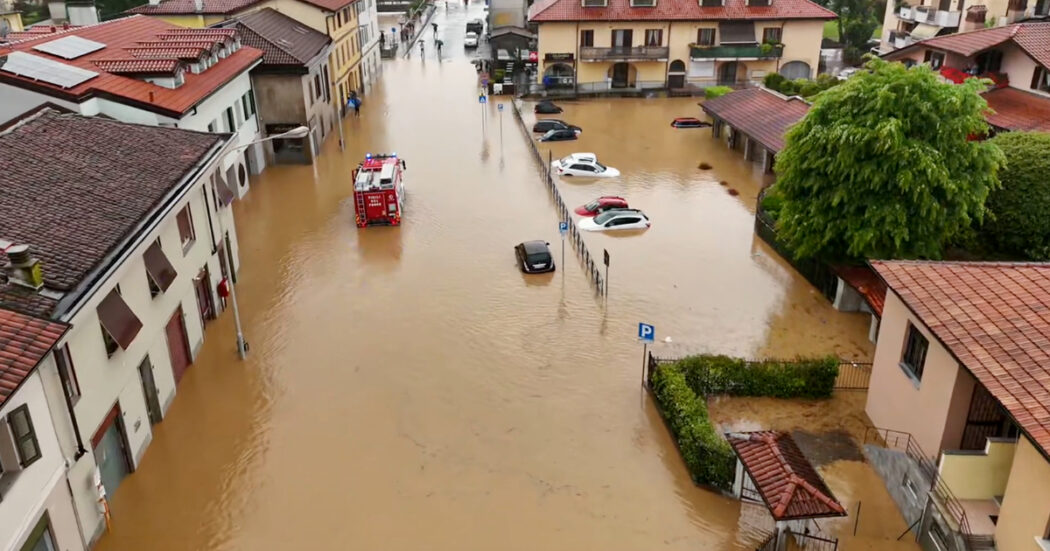Arctic Ocean heating up
The water of the Arctic Ocean is heating up in several ways.
The August 8, 2023, image on the right, from Climate Reanalyzer, shows a 1-3 days forecast of maximum surface temperatures (2m). Heatwaves over land can extend over the Arctic Ocean.
High levels of emissions and greenhouse gases over the Arctic increase the amount of heat that is reaching the water of the Arctic Ocean and the sea ice.
On the second image on the right, a NASA satellite photo shows smoke from forest fires in Canada moving over the Beaufort Sea and over the sea ice on August 6, 2023.
Smoke and soot settling on the sea ice darkens the surface, resulting in more sunlight getting absorbed.
Smoke and soot settling on the sea ice darkens the surface, resulting in more sunlight getting absorbed.
The image below, created with Climate Reanalyzer, shows that the temperature in the Arctic was at a record high for the time of year of 5.61°C or 42.1°F on August 8, 2023, after earlier reaching a record temperature (of 5.81°C or 42.46°F on July 27, 2023).
Arctic sea ice typically reaches its minimum extent half September, when temperatures in the Arctic fall below 0°C and water at the surface starts refreezing.
2. Hot water from rivers ending in the Arctic Ocean is another way the water is heating up.
The August 6, 2023, image below, from nullschool.net, illustrates the added impact of heat that is carried by rivers into the Arctic Ocean, with sea surface temperatures as high as 18.6°C or 65.4°F recorded at a location where the Mackenzie River flows into the Arctic Ocean (at the green circle).
On August 6, 2023, the sea surface was 14.5°C or 26.2°F hotter than in 1981-2011, at a nearby location where the Mackenzie River is flowing into the Arctic Ocean, as illustrated by the image below.
3. Yet another way heat is entering the Arctic Ocean is from oceans, i.e. from the North Atlantic Ocean and the Pacific Ocean, and this is melting the sea ice from below.
Feedbacks and further developments
More generally, the rapid temperature rise threatens to cause numerous feedbacks to accelerate and further developments to occur such as crossing of tipping points, with the danger that the temperature will keep rising.
Ominously, some very high methane levels were recorded recently at Barrow, Alaska, as illustrated by the NOAA image below.
Conclusion
The situation is dire and the outlook is getting more grim every day, calling for a Climate Emergency Declaration and implementation of comprehensive and effective action, as described in the Climate Plan and as most recently discussed at Transforming Society.
• Nullschool
https://earth.nullschool.net
• Climate Reanalyzer - sea surface temperature
• The Threat
https://arctic-news.blogspot.com/p/threat.html
• Climate Plan
https://arctic-news.blogspot.com/p/climateplan.html
• NOAA - Global Monitoring Laboratory - Barrow, Alaska
• Climate Reanalyzer - Outlook Forecast Maps
• Climate Reanalyzer - Daily 2-meter Air Temperature
• The Threat
https://arctic-news.blogspot.com/p/threat.html
• Climate Plan
https://arctic-news.blogspot.com/p/climateplan.html
• NOAA - Global Monitoring Laboratory - Barrow, Alaska
https://gml.noaa.gov/dv/iadv/graph.php?code=BRW&program=ccgg&type=ts
• Dire situation gets more dire every day
https://arctic-news.blogspot.com/2023/07/dire-situation-gets-more-dire-every-day.html
• Transforming Society
https://arctic-news.blogspot.com/2022/10/transforming-society.html
• Climate Emergency Declaration
https://arctic-news.blogspot.com/p/climate-emergency-declaration.html
• Dire situation gets more dire every day
https://arctic-news.blogspot.com/2023/07/dire-situation-gets-more-dire-every-day.html
• Transforming Society
https://arctic-news.blogspot.com/2022/10/transforming-society.html
• Climate Emergency Declaration
https://arctic-news.blogspot.com/p/climate-emergency-declaration.html

 9 months ago
68
9 months ago
68








